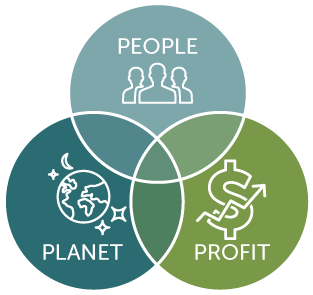Use 'Print preview' to check the number of pages and printer settings.
Print functionality varies between browsers.
Printable page generated Saturday, 20 April 2024, 6:31 AM
Pivoting
Introduction
What is a pivot? Many entrepreneurs start with an idea that provides the impetus to start a business (Katz and Green, 2014). The idea is at the core and your strategy is how and why you will achieve it. However, in his book The Lean Startup, Eric Ries (2011) describes a process common to most start-up ventures – the need to take corrective action to achieve their strategy – something he calls ‘pivoting’.
The purpose of pivoting is to evaluate the feasibility of your product, service and/or business model against your strategy, in order to find a successful formula for making your business idea work. It doesn’t necessarily mean abandoning your strategy completely to start over. Nor does it mean a complete change of direction in every dimension of your product or service. Rather, pivoting is the necessary adjustments you make to achieve your aim. This might be based on market testing, customer feedback, investor feedback or even on an insoluble problem with manufacturing or operations that requires a new approach. The important thing is that you learn from both success and failure and apply the insight you get from this to the future. In this unit you will read about some examples of this.
Eric Ries is an advocate of the minimal viable product (MVP); i.e. the product with the smallest set of features that will satisfy customers. There are a number of advantages to this approach. The logic is that instead of blindly embellishing an idea, investing time, resources and effort in the process, you focus on the most efficient version of your idea that will solve the problem or meet the need. This ensures that your enterprise is up and running more quickly and that you concentrate on the fundamental ways in which your product or service will satisfy your customers. Ries recommends a prototype or MVP is used to test and learn in the marketplace to allow for iteration of the idea.
1 Does pivoting mean you got it wrong?
Pivoting does not necessarily mean you got it wrong. Another way to think of pivoting is that it allows you to make improvements to your product. These improvements will depend on the information fed back to you by market research, by your customers and from observing your financial situation and how efficiently your operations work.
Feedback can inform you of what features and benefits are valuable and viable with customers versus those that are less popular and don’t add value. Perhaps most importantly feedback allows assumptions about customers to be tested. For example, through getting to know your customers better, you might establish that in fact the problem you thought you were solving is a different one. Through testing and learning, corrective action can be taken – i.e. the pivot.
One argument against the minimal viable product idea is that, by launching too early, your idea may be just too rough and ready for the vast majority of customers who prefer the glitch-free, smooth user experience of the polished, final iteration. But, as was said above, this really means being sure that you are adding value and not simply building in costs for features that are unsustainable.
An important consideration is whether changes allow you to balance quality, costs, prices and market positioning (e.g. how your product or service is perceived in relation to competitors’ brands or similar solutions) with your own capacity to meet demand. Clearly, if you cannot supply and sustain quality at scale, then you will have to reconfigure your business substantially or risk losing customers from failure to meet expectations. This may mean either seeking investment to grow your capacity or the recognition that you are a high-margin, low-volume business.
2 When might you pivot?
There are different ways in which you can expect to ‘pivot’ your product or business idea and some of these are expanded upon in the next section.
The first thing to say is that pivoting is not done lightly. It should be done with good reason, careful thought and planning to ensure that any potential knock-on effects are understood. Pivoting is designed to lead to success in the marketplace, so understanding your growth and potential to scale up requires a realistic assessment of the size of your market, and an assessment of how competitive it is.
However, when you consider your own progress in relation to the opportunities, you might ask:
Is your business gaining as much traction in the marketplace as it should be? Did you get the take-up you forecast?
Is your business still growing?
Is your business competing with other companies, perhaps some bigger and better resourced?
If the answer to these questions is no, no and yes respectively, blindly throwing more time and resources at the situation is unwise.
Look carefully at what the feedback is telling you about what works for your customers. Timing of this feedback is important, and what it tells you may vary depending on the buying cycle for your product or service. For example, for a high-value, infrequent purchase, the time lag between purchase, use and discovering issues will be much longer than for a frequent low-value purchase, such as a snack, where the feedback may be much more immediate.
The feedback may lead you to consider a number of alternative actions, some of which are covered in the next section.
3 Types of pivot
Having considered your feedback, you then have to decide what changes to make. This is where pivoting comes in. There are several ways in which you can do this, which are described in the following sections.
3.1 Simplification
Simplification is when you zoom in and strip out features to focus on one specific feature that ultimately becomes the whole product or service. The rest is ‘gilding the lily’. One big brand that provides a good example is YouTube – the video streaming service. It started out as a video-based dating service. By focusing on the video hosting aspect, they slowly became the successful company that was later to be acquired by Google.
3.2 Zoom out
The zoom out is in many ways the opposite of simplification. Zoom out is when one feature goes on to produce something larger. An example of this was a social platform called The Point. Originally intended to allow groups to form via a platform in support of good causes, it harnessed the power of the crowd. The platform pivoted to become the basis for Groupon, which uses buying power to negotiate group discounts.
3.3 Customer segment
A customer segment pivot may be needed when you have designed and developed a product or a service, which solves a problem or meets the needs of one customer group, but ultimately sales growth is limited. One explanation for this may be that, while your original idea is attractive to early adopters, it does not turn out to be as attractive or relevant to the much bigger mainstream market.
Technology products are a good example. Early adopters of new technologies tend to be more forgiving of lower quality design features, technical glitches and shortcomings of something new, as often their own technical ability outweighs their dependency on suppliers to iron out teething problems.
Early DOS-based computers relied on people entering coded instructions to operate the machines. In order to reach the mainstream market, the computers needed overhauling and simplifying to appeal to a wider market of people unfamiliar with technology. The PC was born and the rest is history.
Activity 1 Evolution of computers
Think of your own consumer experience of computer products. What product features and attributes could you point to that have made a difference to mass market adoption?
Discussion
Depending on how old you are, your knowledge of early computers may be limited, or confined to what your online research or older friends and relatives can tell you!
One obvious invention that brought computing to the mainstream was arguably the move to a Windows-based system, which made it less necessary to understand computer languages and commands. The internet also opened up a whole new use for computing. The increasing power, data storage capacity and reducing size of computers also benefited home users. More recently, apps have provided a means to pull in data and information from various sources to provide uses through a simple interface on phones and tablets.
Today, computing is almost everywhere around us – on our bodies (watches and other wearable technologies), in our cars, in domestic appliances and, for very many people, in our workplaces.
3.4 Business model
A business model pivot is one where the customer base changes. If you are unsure of what is meant by the term ‘business model’, review the unit Developing your business model.
We have seen a trend towards business model pivoting in a number of businesses. For example, coffee machines, printers and other hardware that perhaps were originally aimed at offices and businesses are now also increasingly aimed at end users (e.g. homeworkers) who also want access to them.
Indeed, the pricing of such machines and gadgets has come down as it has been recognised that often it is the consumable elements (e.g. pods and cartridges) that provide a greater income from a mass market.
Activity 2 From business-to-business to business-to-consumer
Think of any product that was available only to businesses, which later became available to end users or consumers.
What adaptations might the product maker have made to their business’s product and marketing strategy in order to make the product available to this new customer base?
Discussion
Many possible examples come to mind, but here is one: hairdressing.
Hairdressing supplies often start by being available only through salons (think of gels, mousses, straighteners, curling tongs, hair clippers and so on). In this case, the product maker would have to consider a completely different distribution strategy, as they were only targeting hair salons, perhaps through a direct sales force and a wholesaler network. This strategy would not be appropriate for making the product range available to a wider public.
To reach this wider group, a new distribution network through retailers would be required. Some might deploy celebrity endorsement; e.g. making use of famous hairdressers rather than relying on the technical specification of products that professional hairdressers might consider when differentiating between suppliers.
The product maker could consider packaging smaller volumes of product. If they also included user instructions, this would allow amateur stylists to achieve similar results to professionals.
Pricing is also clearly another aspect of the marketing mix that would have to be changed to reflect the smaller purchasing power of individuals versus the bulk buying by salons.
3.5 Customer need

Customer need describes a situation where, having come to know your customers very well, you recognise that the product or idea you have is not vital or important enough to them to make them switch from their existing product, supplier or behaviour.
How would you know this was the case and that you need to respond by pivoting?
You might find that people are not prepared to pay what you ask for your service or product, or that the need is not as strong as you thought it was to make the customers switch their behaviour. Your options are either to explore whether, with better positioning of your idea in the marketplace, customers will come around (e.g. you have a communication need or need to make adjustments to the product specification or perhaps to pricing) or to decide there is a more radical need to find a different product to serve the confirmed customer need.
Bear in mind that some products may simply be ahead of their time, which may have been the case for early ‘green’ products to which the mass market is now much more receptive.
3.6 Technology pivot

A technology pivot means switching to a new platform or delivery system. There have been many companies who have tried to design that one ‘killer application’ that everyone will want, only to find that they don’t! However there are several examples of companies that have successfully used what they have in another dimension, one of which is Worldpay.
Worldpay originally sought to be an online shop. Soon they recognised that they had not designed into their platform the need to operate across international boundaries and currencies. This led to the development of their payments software, which now powers many online retailers around the world. In fact, recently Worldpay was bought by US-based company Fidelity National Information Services for $35 billion.
Activity 3 Worldpay’s technology pivot
Read Worldpay’s story and then make a list of the key events and trends that led to its meteoric rise in value since it started in 1989.
WorldPay payments firm in $43bn sale to US rival (BBC News, 2019)
Discussion
Here are the points we picked out:
Change of ownership – bought by NatWest Bank, who were then acquired by Royal Bank of Scotland (RBS)
International expansion
Regulatory enforced sale by RBS as a condition of their public buyout following the financial crisis
Technology-related changes leading to a massive increase in e-commerce and in particular how payments are made. Therefore more customers are making purchases online, and banking online meaning that more banks, retailers, restaurants and bars are using digital payment systems.
3.7 Motive pivot
One final example of pivoting is worth considering and is perhaps the hardest to pull off.
Can you switch from being a social enterprise to one that makes a profit, or vice versa? In other words, is this change of motivation possible to pull off as a form of ‘motive pivot’?
‘OneLeap’ was founded by alumni of the Gates Cambridge Scholarship Programme (Pasolini, 2012). It is a web-based platform that allows entrepreneurs, investors, the business community and influencers to network and, in the process, raise money for the charities of their choice.
In his book, How to be a Social Entrepreneur, Robert Ashton (2010) highlights that, as grant funding inevitably seems to decrease, there is an increasing need for vital services and causes like health, education and social welfare to resort to profit-making activities to allow for more good to be done.
But, as Ashton also points out, not all social entrepreneurs are founders of social enterprises. Social entrepreneurs may work in ethical businesses, in the public sector or in the voluntary sector. In fact, one of the founders of The Open University – Michael Young, who also founded the School for Social Entrepreneurs – could be described as a social entrepreneur. Another example is the work that celebrity chef Jamie Oliver has done to establish training and employment opportunities for young people in catering.
Summary
Pivoting is a positive shift in strategic thinking about your idea or enterprise. It involves using observation and feedback about how your product, service or concept is perceived in the marketplace to make necessary adjustments. Pivoting is a recognised way of establishing the right customer fit with your value proposition and it may involve subtle shifts in operations.
It may be necessary to pivot to ensure that your market positioning is aligned with your brand values, your pricing is appropriate, you are targeting the right customers or even how you distribute your product. There are many possible ways in which you may have to adjust course through the lifetime of your business.
Being alert to what is happening in the marketplace, with competitors and, most importantly, with your customers, will provide valuable data and insights to inform why your progress is stalling or failing to meet your customers’ expectations. With deeper consideration and analysis, issues are highlighted and then with careful planning and execution, corrective action can be taken. However the key thing is to remember that in a pivot, one foot remains firmly in place, grounding you to your original ideas and values while the shift in direction is about finding new ways to achieve them.
Further reading
Carlton (2016) ‘The ten types of business model pivots in lean startup’, Look Forward Consulting, 30 June [Blog]. Available at https://lookforwardconsulting.com/ 2016/ 06/ 30/ ten-types-business-model-pivots-lean-startup/ (Accessed 19 March 2019).
DeMers, J. (2018) ‘5 big brands that had massively successful pivots’, Entrepreneur Europe, 15 February [Online]. Available at https://www.entrepreneur.com/ article/ 308975 (Accessed 14 December 2018).
Founder Institute (2018) ‘What pivoting is, when to pivot, and how to pivot effectively’, 27 August [Blog]. Available at www.fi.co (Accessed 10 December 2018).
GatesCambridge (2012) Money vs Mission [Online]. Available at https://www.gatescambridge.org/ news/ money-vs-mission (Accessed 19 March 2019).
Ries, E. (2012) ‘Eric Ries: 10 classic strategies for a fast, user-focused company reboot’, excerpt from The Lean Startup made available by the Fast Company [Online]. Available at https://www.fastcompany.com/ 1669814/ eric-ries-10-classic-strategies-for-a-fast-user-focused-company-reboot (Accessed 19 March 2019.
Smale, W. (2017) ‘Meet the world’s youngest self-made billionaire’, BBC News, 20 November [Online]. Available at https://www.bbc.co.uk/ news/ business-41859941 (Accessed 19 March 2019.
Zwilling, M. (2011) ‘Top 10 ways entrepreneurs pivot a lean startup’, Forbes, 16 September [Online]. Available at https://www.forbes.com/ sites/ martinzwilling/ 2011/ 09/ 16/ top-10-ways-entrepreneurs-pivot-a-lean-startup/ #206c06152d2b (Accessed 19 March 2019.
Zwilling, M. (2016) ‘8 ways to pivot your business to kickstart growth’, Entrepeneur Europe, 15 June [Online]. Available at https://www.entrepreneur.com/ article/ 277285 (Accessed 19 March 2019).
References
Acknowledgements
Every effort has been made to contact copyright holders. If any have been inadvertently overlooked the publishers will be pleased to make the necessary arrangements at the first opportunity.
Important: *** against any of the acknowledgements below means that the wording has been dictated by the rights holder/publisher, and cannot be changed.
Grateful acknowledgement is made to the following sources:
Figure 1: © Aleksandr Khakimullin / 123 Royalty Free
Figure 2: © Thinglass / Shutterstock
Figure 3: © Iulia Brovchenko / 123 Royalty Free
Figure 4: © YAY Media AS / Alamy Stock Photo
Figure 5a: © photografier / 123 Royalty Free
Figure 5b: © Varin Rattanaburi / 123 Royalty Free
Figure 6: © popoimagen / iStock / Getty Images Plus
Figure 7: Grant Mitchell. This file is licensed under the Creative Commons Attribution Licence http://creativecommons.org/ licenses/ by/ 3.0/
Figure 8: © johnkellerman / iStock / Getty Images Plus
Figure 9: University of Wisconsin







